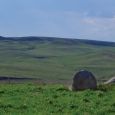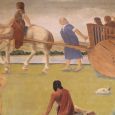The Gift of South Dakota
Subscriptions to South Dakota Magazine make great gifts!
Subscribe today — 1 year (6 issues) is just $29!
Pollock's Three Stone Idols
On a balmy afternoon I traveled to visit the stone idols mentioned two centuries ago in Captain William Clark’s 1804 journal chronicling his voyage of discovery with Meriwether Lewis up the Missouri River. Clark’s entry for October 13, 1804 reads as follows:
“Passed a creek on the starboard (east) side (of the Missouri) 13 yards (wide) at 18 miles above the (Arikara) town (near the mouth of the Grand River) heading in some ponds a short distance to the northeast we call Stone Idol Creek. Nearly opposite (parallel to) this creek a few miles from the river on the starboard (south) side 2 stones resembling human persons & one resembling a dog is situated in the open prairie. To those stones the Arikara pay great reverence, make offerings &c. whenever they pass. Those people have a curious tradition of (regarding) those stones. One was a man in love, one a girl whose parents would not let her marry. The dog went to mourn with them, all turned to stone gradually, commencing at the feet. Those people fed on grapes until they turned, & the woman has a bunch of grapes yet in her hand. On the river near the places those are said to be situated, we observed a greater quantity of fine grapes than I ever saw at one place.”
From his journal, it seems Clark did not visit the stones and was only repeating a story related to him by an interpreter from Chief Pocasse as the party passed the mouth of the creek. For nearly two centuries, the stone idols remained an enigma in Clark’s journal until a local farmer and former history teacher, Denny Jensen, started putting together clues. While moving some boulders from the previous land owner’s rock pile to nearby West Pollock Resort, he discovered three large chunks of granite that he thought fit the description of the shape and the location of the stones described in Clark’s journal.
The idols are technically boulders that were pushed hundreds of miles from the east during an early glacial advance and deposited on a low hill on the western edge of the Missouri Coteau hundreds of thousands of years ago. Looking at them in the early part of the afternoon, they appeared to be nothing more than two big pink boulders and a smaller black one curiously placed together.
Then I shifted position both mentally and physically, relaxed and backed up a bit. From the southwest, with the sun on their faces in the late afternoon, I could see the female wrapped in a shawl, reclining with the male standing attentively, almost rapturously gazing at his companion. The dog sits quietly on its haunches a step behind the male. It’s actually a lovely tableau — tender and tranquil.
But the idols’ surroundings have changed since the days of Lewis & Clark. Where once a riparian forest with big trees grew entwined “with a great quantity of fine grapes” now stretches the wide, treeless shore of Lake Oahe. Stone Idol Creek, now Spring Creek, is part of Oahe’s backwater called Pollock Bay.
Nudged back together into the 21st century by Jensen and his tractor, the stone idols sit reflectively again on the brow of a low ridge above the creek, but instead of being surrounded by native grass, they are at the edge of a hayfield. Southwest, below the idols, is the bustling recreational complex of West Pollock Resort.
Clay Jenkinson, a prominent Lewis & Clark scholar, examined the stones in 2001 and told the Aberdeen American News, “If these stones prove to be the exact stones, it would not surprise me. They’re in the right place, and with a small amount of imagination, they can be construed as a man, a dog and a woman.”
Michael Fosha, assistant state archaeologist, inspected the rocks at Jensen’s request and noted in the same article, “While we may never know which of the stones were the human and dog effigies, it is my opinion that you have identified the approximate location (where) these objects originally set.”
Apparently, the Arikaras were romantics and appreciated a good, if doomed, love story with a focus on devotion and commitment between two young people. Wild grapes, locally abundant, proved to be the hemlock that would ultimately preserve their fervor and ossify it.
Around 5 p.m., a low-lying deck of storm nimbus blue in from the northwest and slowly occluded the sky. Like a great thunder eagle, the cloud shadow slowly spread its wings across the land and absorbed the stone idols into the flat, even half-light of an early evening that completely enveloped the land. The spell was broken and it was time to go.
When I got up to leave, a thought crossed my mind — if I ever returned, it might be appropriate to leave a votive offering, flowers maybe, or perhaps a purple bunch of grapes and a wish for happiness.
Find the Idols
The stone idols require a certain meditative frame of mind, patience and imagination. Find them by taking Highway 1804 about a mile south of Pollock to the West Pollock Resort sign turnoff. Drive two miles west to the resort and then ask for directions in the resort restaurant.
Editor's Note: The author, Edward Raventon, is a naturalist, outdoor writer and photographer, focusing on the natural and cultural history of the Northern Great Plains and the Black Hills. This story is revised from the September/October 2007 issue of South Dakota Magazine. To order a copy or to subscribe, call 800-456-5117.











Comments
he land owner isn't into history.
I don't know who it is.